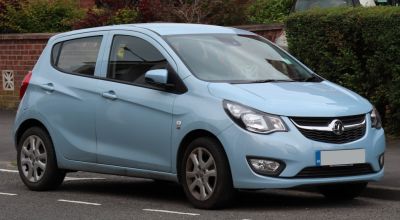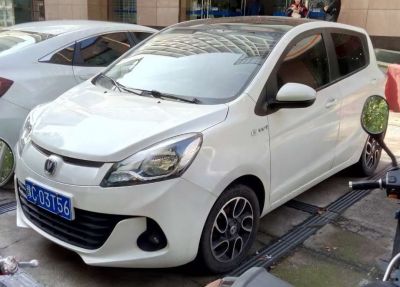 2015 Opel Karl Dimensions, Size & Specs
2015 Opel Karl Dimensions, Size & SpecsMeasurements of the 2015 Opel Karl, engineered for optimal performance and comfort
| Dimensions | |
|---|---|
| Length: | 3675 mm144.7 in12.1 ft |
| Width: | 1595-1604 mm62.8-63.1 in5.2-5.3 ft |
| Width (Folded Mirrors): | 1698 mm66.9 in5.6 ft |
| Width (Opened Mirrors): | 1876 mm73.9 in6.2 ft |
| Height: | 1476-1485 mm58.1-58.5 in4.8-4.9 ft |
| Trunk Capacity: | 206 liter7.3 cu ft |
| Trunk Capacity (Max): | 1013 liter35.8 cu ft |
| Weight Specifications | |
| Curb Weight: | 864-950 kg1905-2094 lbs |
| Maximal permitted Weight: | 1353-1410 kg2983-3109 lbs |
| Tire Specifications | |
| Rims Sizes: | 14-inch rims:
|
| Tire Sizes: |
|
The Opel Karl, produced between 2015 and 2019, is a compact hatchback designed for urban mobility and practicality. With a length of 3675 mm (144.7 inches), it fits neatly into the city car segment, offering easy maneuverability in tight spaces. Its width ranges from 1595 to 1604 mm (62.8 to 63.1 inches), and with folded mirrors, it measures 1698 mm (66.8 inches), extending to 1876 mm (73.9 inches) when the mirrors are opened, making it convenient for narrow parking spots. The height varies between 1476 and 1485 mm (58.1 to 58.5 inches), providing a balanced profile that still offers good headroom and comfort inside.
The curb weight of the Opel Karl spans from 864 to 950 kg (1905 to 2094 lbs), with a maximum permissible weight of 1353 to 1410 kg (2982 to 3109 lbs), reflecting its lightweight construction aimed at fuel efficiency and agile handling. This model's luggage space is practical for daily use, offering 206 liters (7.3 cubic feet) of cargo capacity with the rear seats up, expandable to a generous 1013 liters (35.7 cubic feet) when the rear seats are folded down. These features highlight its adaptability for both passengers and cargo, catering well to small families or individuals needing flexible storage.
The Opel Karl rides on rims sized 5J x 14 or 6J x 15 and comes with tire sizes 165/65 R14 or 185/55 R15, depending on the variant, enhancing ride comfort and efficiency. Overall, the Opel Karl from this generation represents an ideal city car option offering compact dimensions, lightweight design, and flexible cargo solutions, making it a practical choice for everyday urban driving and small load transportation.
Discover the standout features that make the 2015 Opel Karl a leader in its class
Have a question? Please check our knowledgebase first.
The Opel Karl, produced between 2015 and 2019, is a compact hatchback designed for urban driving and efficiency. It measures 3675 mm (144.7 inches) in length, making it relatively short and easy to maneuver in tight city spaces. The width ranges from 1595 mm (62.8 inches) to 1604 mm (63.1 inches) excluding mirrors, providing a narrow profile that supports easy parking. When including folded mirrors, the width increases to 1698 mm (66.8 inches), and with the mirrors fully open, it reaches 1876 mm (73.9 inches). The height of the Opel Karl varies slightly from 1476 mm (58.1 inches) to 1485 mm (58.5 inches), offering adequate headroom without exceeding typical subcompact car dimensions. These dimensions characterize the Karl as a small, nimble vehicle ideal for city use.
The Opel Karl has a curb weight ranging from 864 kg (1905 lbs) to 950 kg (2094 lbs), depending on specific trims and equipment. This lightweight design contributes to fuel efficiency and agile handling characteristics. The maximum permissible weight, or gross vehicle weight, ranges from 1353 kg (2983 lbs) to 1410 kg (3109 lbs). This maximum weight accounts for the vehicle's own weight plus passengers, cargo, and any additional load. The relatively low curb weight allows the Karl to provide peppy performance with smaller engine options while maintaining good fuel economy. It's essential to respect the maximum weight limit to ensure safety, vehicle integrity, and performance.
The Opel Karl offers a versatile cargo area for a car of its size. With the rear seats in their upright position, the luggage capacity is 206 liters (7.28 cubic feet), suitable for small grocery runs, briefcases, or backpacks. When additional space is needed, folding down the rear seats expands the cargo volume significantly to 1013 liters (35.74 cubic feet). This expansion makes it practical for carrying larger items like bicycles, suitcases, or bulky shopping. Despite its compact exterior, the Karl balances passenger space with flexible cargo solutions, allowing it to handle various everyday transportation needs efficiently.
Yes, the Opel Karl is well-suited to fit into a standard home garage. Its compact length of 3675 mm (144.7 inches) and width, including folded mirrors at 1698 mm (66.8 inches), makes maneuvering in enclosed garage spaces straightforward. Standard residential garages typically measure at least 2400 mm (94.5 inches) in width and 4800 mm (189 inches) in length, which comfortably accommodates the Karl’s dimensions with room to spare for opening doors and movement around the vehicle. Additionally, the relatively low height of approximately 1480 mm (58.3 inches) ensures compatibility with most garage door heights. This size suitability makes the Karl especially popular among city dwellers who often face parking constraints.
The Opel Karl’s width without mirrors ranges between 1595 mm (62.8 inches) and 1604 mm (63.1 inches), which represents the body width of the car itself and is the key measurement for fitting in narrow parking spaces or lanes. However, when the side mirrors are unfolded, the total width extends significantly to 1876 mm (73.9 inches). This wider footprint when mirrors are open must be considered in tight parking scenarios or narrow streets to avoid contact with obstacles or other vehicles. Interestingly, the width with folded mirrors is 1698 mm (66.8 inches), which is a useful intermediate measurement for tight parking situations where folding mirrors is possible.
The Opel Karl is equipped with rim sizes ranging from 5J x 14 inches up to 6J x 15 inches depending on the trim and optional packages. Correspondingly, the tire sizes typically found on different variants include 165/65 R14 and 185/55 R15. The 14-inch wheels (165/65 R14 tires) are generally found on the more basic models, prioritizing comfort and economy. Meanwhile, the 15-inch wheels (185/55 R15 tires) are often fitted on higher trims for a sportier appearance and potentially improved handling dynamics due to a larger contact patch and possibly lower sidewall profile. These wheel and tire sizes balance cost, comfort, and driving performance suitably for a small city hatchback like the Karl.
The Opel Karl's height varies slightly from approximately 1476 mm (58.1 inches) to 1485 mm (58.5 inches). This relatively modest height ensures that the vehicle remains low-profile and aerodynamic while still providing sufficient interior headroom for average adults. The compact height supports good vehicle stability by lowering the center of gravity, which helps reduce body roll during cornering and enhances handling. Additionally, the balanced height contributes to easier ingress and egress for passengers without the elevated stance found in taller vehicles like SUVs or crossovers. As a result, the Karl is designed to maximize comfort inside while maintaining safe road manners in urban and suburban settings.
The Opel Karl replaced the Opel Agila as a subcompact city car, bringing a more modern design and updated technology. Dimensionally, the Karl is somewhat similar but slightly more streamlined. The Karl measures 3675 mm (144.7 inches) in length, which is comparable but usually a bit less than the last Agila models, making it more agile in urban settings. Width-wise, the Karl's 1595-1604 mm (62.8-63.1 inches) range is slightly narrower than some versions of the Agila, enhancing maneuverability. The height between 1476-1485 mm (58.1-58.5 inches) on the Karl is generally lower than the taller Agila model, which was designed as a small MPV with a more upright stance. The Karl’s reduced height and sleeker profile improve aerodynamic efficiency and driving dynamics, representing a shift towards a more passenger-car-like feel compared to the practical but boxier Agila.
In the segment of city-friendly small hatchbacks, the Opel Karl holds its own with competitive dimensions and practical features. Its length of 3675 mm (144.7 inches) positions it among the shorter subcompact cars, facilitating easy parking and navigation in tight urban environments. For example, it is similar in length to cars like the Volkswagen Up! and the Fiat Panda, but tends to offer slightly more luggage space when seats are folded, with a maximum of 1013 liters (35.74 cubic feet). The Karl’s width (up to 1604 mm, 63.1 inches) is typical for the class but combined with its low height offers good stability and passenger comfort. Its lightweight (curb weight from 864 kg or 1905 lbs) translates into fuel efficiency and nimbleness, qualities often prized in city cars. Overall, the Opel Karl balances compact size with clever interior packaging, making it a practical and efficient choice compared to rivals.
The Opel Karl is a subcompact hatchback primarily designed for urban and suburban driving. Emphasizing efficiency, ease of parking, and affordability, it targets drivers who need a small but practical car for daily commuting, errands, and occasional longer trips. Despite its compact size, the Karl offers thoughtful interior space with flexible cargo capacity—206 liters (7.28 cubic feet) with all seats up and 1013 liters (35.74 cubic feet) with rear seats folded. The vehicle is lightweight and easy to maneuver, making it ideal for city streets and crowded environments. Its modest height and width enhance stability and accessibility, while options for different rim and tire sizes allow buyers to customize handling and comfort. Overall, the Opel Karl is well-suited for individuals, couples, or small families seeking a reliable and economical urban transport solution.
Discover similar sized cars.

| Production: | 2016-2020 |
|---|---|
| Model Year: | 2016 |
| Length: | 3746 mm147.5 in |
| Width: | 1647 mm64.8 in |
| Height: | 1535 mm60.4 in |

| Production: | 2015-2018 |
|---|---|
| Model Year: | 2015 |
| Length: | 3675 mm144.7 in |
| Width: | 1876 mm73.9 in |
| Height: | 1485 mm58.5 in |

| Production: | 2015-present |
|---|---|
| Model Year: | 2014 |
| Length: | 3730 mm146.9 in |
| Width: | 1650 mm65.0 in |
| Height: | 1530 mm60.2 in |
